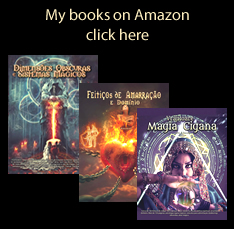In Wicca, and in other magickal traditions, several magical tools are used, some to decorate the Altar and others to practice rituals.
In fact, these instruments are only accessories, contain some symbolism
and channel our power (such as Athame, the magick wand, and others).
Pentacle:
The Pentacle or pentagram (five-pointed star) can be used in the form of
a disc, to decorate the altar, or even to serve as a base and cut herbs on it
or enshrine a talisman on it.
The Pentagram represents the microcosm (human being) with open arms, it
also symbolizes the five elements (Earth, air, water, fire and spirit).
The Pentacle is connected to the Earth and the altar is positioned at
the northern cardinal point.
Athame:
It is a small double-edged ceremonial dagger, sometimes including
magical symbols engraved on its blade. It serves to direct and manipulate the
energies in a ritual, it is an extension of the magician's body. It is with
Athame that the magick circle is drawn.
The Athame is connected to the element Air and the altar is positioned
at the cardinal point East.
Bolline:
Bolline is a knife with a white handle, which is normally used to
harvest herbs and record inscriptions. It is a practical knife for magickal
work.
Wand or stick:
The use of the wand is similar to that of the Athame and can be used for
the same functions.
It is made with a tree branch, with a copper or bronze tube with a
crystal tip at one end.
The most common woods to make a magick wand are willow, oak, hazel and
birch. If you don't find any of these trees in the region where you live, you
can make your wand with a branch of any other that has meaning for you.
The Staff is connected to the element Fire and in the altar is
positioned at the South cardinal point.
Some mages use a large scepter, or staff, which also serves to direct
energies as well or open a magick circle.
Chalice:
The Chalice is used to contain wine, water and other sacred drinks to be
ingested during a ritual.
Most Chalices are made of silver, but can have one of any other material
like ordinary glass, crystal, tin, steel.
The Chalice represents the Goddess and the fertility of life and is used
in the ceremony of the Great Rite, which represents the union of the Goddess
and the God, when the blade of the Athame is immersed in the liquid contained
within it.
It is connected to the element Water and at the altar is at the West
cardinal point.
Cauldron:
Perhaps it is the most well-known magick Instrument. It is used to make
beneficial potions and spells in order to heal, inspire peace and happiness.
The Cauldron represents the power of transformation and is usually made
of iron, having a tripod that represents the three faces of the Goddess.
It is in the center of the altar, representing quintessence, the element
Spirit and the union of the 4 elements.
Bell:
It is used to mark the beginning and end of a ceremony. It can also be
used to clean a place or our auric field with vibrations. It can be used to
invoke positive energies, Gods and Spirits from the elements.
Incensaries:
To burn incense.
Candlestick:
For candles.
Hooded Robe or Cloak:
It is not exactly a tool, but a ceremonial clothing.
In Shamanism ritualistic objects are used as well:
Tambourine:
A kind of hand drum. Rhythmic beats on the tambourine help to achieve a
trance state.
Most of the time, tambourines are made of several types of genuine
leather: goatskin, cowhide, and other less common types such as bearskin, deer,
horse, buffalo, bison etc.
Rattle:
The rattle serves to summon spirits from various directions, cardinal
points, three worlds, ancestral spirits.
The sound of a rattle, sharkun (a
type of rattle made of birch bark), was believed to scare evil spirits.
Rattles can be made of leather, birch bark, wood or plastic. There are
even rattles made of a plastic bottle with small objects inside, such as
grains, stones, etc.
Medicine bags:
These bags, normally made of leather, were known by several names: Be it
medicine bags, talisman bags, sachet, or others.
Inside could have seeds, crystals, pieces of bones, symbols of the
shaman's animals of power, objects for spiritual protection or healing, luck in
hunting, etc.
They functioned as an amulet, similar to the patuá bags in Brazil or Mojo
bags in Voodoo.
Sometimes I write magick or magickal instead of "magic", the "K" serves to differentiate witchcraft (real magic) from illusionism. In occult grimoires and occult circles they always refer to magic as magick.
Asamod
Read Questions and Answers.























